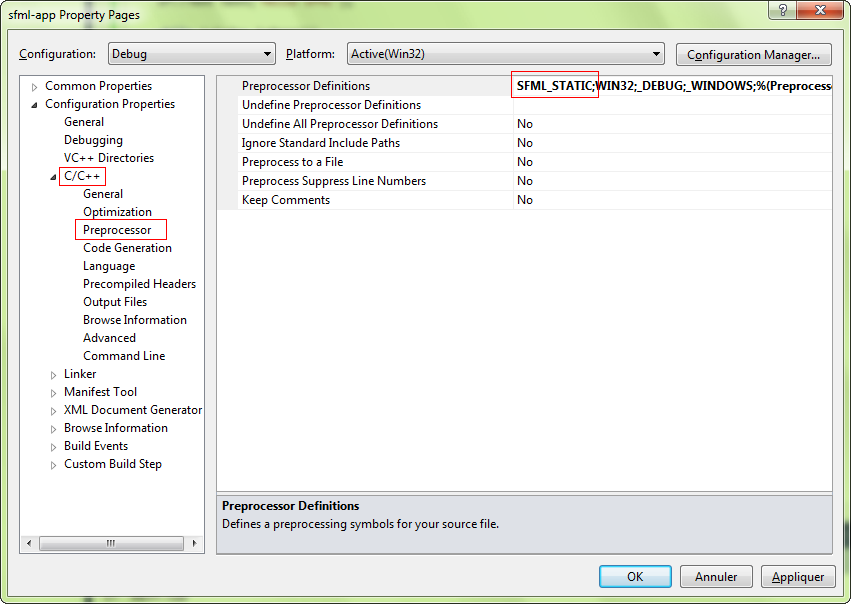

- Visual studio sfml how to#
- Visual studio sfml software license#
- Visual studio sfml zip file#
- Visual studio sfml archive#
- Visual studio sfml code#
Since 2006, OpenGL has been managed by the non-profit technology consortium Khronos Group. (SGI) began developing OpenGL in 1991 and released it on Japplications use it extensively in the fields of computer-aided design (CAD), virtual reality, scientific visualization, information visualization, flight simulation, and video games. The API is typically used to interact with a graphics processing unit (GPU), to achieve hardware-accelerated rendering. OpenGL ( Open Graphics Library ) is a cross-language, cross-platform application programming interface (API) for rendering 2D and 3D vector graphics.
Visual studio sfml software license#
: This is a Free Software License B closely modeled on BSD, X, and Mozilla licenses. Open source license for use of the S.I.Now your “game” should be ready to run, hit F5:Ĭongratulations, you just completed your first successful SFML project. This folder actually contains both debug and release dlls, and you only need the debug for now, but disk space is cheap, no? 🙂 We will cover building for release at a later date and I will go into the difference in more details then.

Visual studio sfml zip file#
Now, remember the SFML zip file I told you to keep open? Switch back to it and select the contents of the bin folder:Īnd paste them into your Debug directory. Assuming your build went without errors, you should now have a Debug folder inside your project directory, like so: Don’t run it yet, it wont work without the DLLs, but we need to build it once to have the proper folders made. Under linker, select Input, then locate Additional Dependencies on the right.Īssuming you are using all of the components of SFML and linking to DLLs ( see video for more options ), click in the white area and select edit and add the following (order is important!): On the left hand side select Linker instead of C++ then Additional Library Directories: Make sure to hit enter and it goes bold so you know your setting was saved. In the resulting dialog, select C++ on the left, then Additional Include Directories:Įnter the following value (for more detailed explanations, watch the video, it goes more into the why of things): Right click your project and select Properties: Now that we have the libraries and header files copied into our project, we need to tell Visual Studio about them. Leave the SFML folder open, we will need it again in a second.

The contents should look something like this:Ĭopy the folders include and lib to your project directory, which should now look something like this:
Visual studio sfml archive#
Open up the archive you downloaded earlier from sfml. You will notice lots of errors in Visual Studio, like so:ĭon’t worry, we will fix these in a second. #include "SFML/Graphics.hpp" int main ( int argc, char ** argv ) Now choose C++ file and name it Main.cpp. In solution explorer, right click your the Source Files folder in your project and choose Add->New Item.
Visual studio sfml code#
We now have a project, let’s add a bit of code to it. Name it and locate it however you want then click ok.Ī new window will pop up, click next, then on the next screen, I used the following settings: Now load up Visual Studio and create a new C++ project of type Win32 Console Application: Now that we have SFML downloaded, extract the resulting zip file somewhere.

In the end though, it doesn’t really matter which one you choose, just be aware of the results. Additionally, for a 2D game, 64bit doesn’t really get you all that much in return. A 32bit binary can run on a 64bit OS, but not the opposite. This is especially true if your game is meant to run on Windows XP. Keep in mind, even though you OS is 64bit, it is likely that you want to use the 32bit version. This mostly comes down to identifying what C++ compiler you are using as well as the “bit-ness” you want to target. Now you need to figure out which version to download. Head on over to the SFML download page and select the newest SFML version, as of writing 2.3.2: If you are running Visual Studio 2015 instead, the process should be virtually 100% identical, although you will have to download a different set of files.įirst you need to download a version of SFML.
Visual studio sfml how to#
This text tutorial is a companion to this video tutorial showing how to create and configure a new SFML project using Visual C++ 2013.


 0 kommentar(er)
0 kommentar(er)
